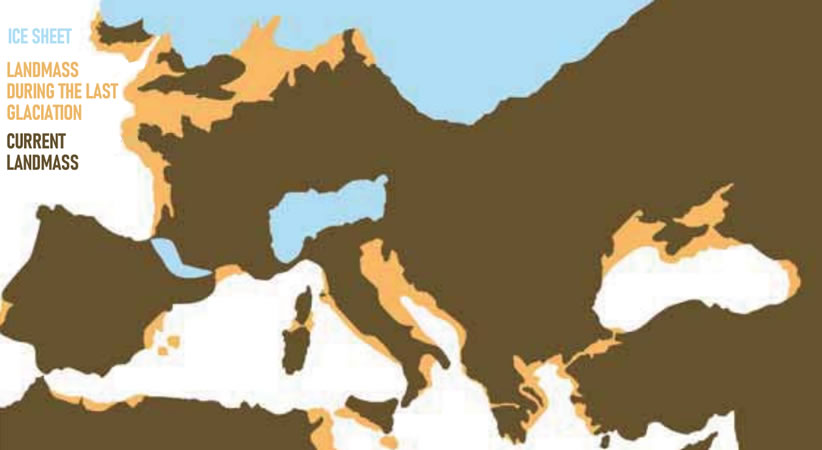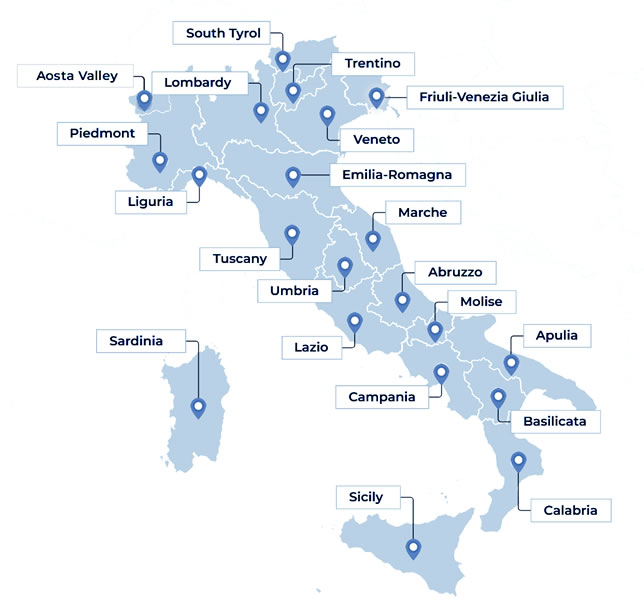

Explore Italy by place | region | time period
The Paleolithic Age » Lamalunga Cave (Altamura, Apulia)
Until about 40,000 years ago, Homo sapiens shared the planet with Homo neanderthalensis.
This species' scientific name means Neander Valley Human, named for the place where their remains were first discovered in Germany in 1856.
Neanderthals migrated into colder northern climates. To adapt and to preserve heat, they were shorter legs and a stockier build than modern humans. We don’t know if they had some form of language, but had the capacity to produce and hear human-like speech. They lived in small family groups and in shelters, made sophisticated stone tools and weapons to hunt large animals, wore clothing, controlled fire, fed on venison and wild fruits, carved jewelry out of bone, created colored pigments to paint shapes on cave wall, sand deliberately buried their dead.

Despite these capabilities, the Neanderthals rapidly declined following a large migration of Homo sapiens into Europe (Capo Rossello). Around 40,000 years ago, the Campi Flegrei volcano (Naples, Italy) erupted, and caused a disaster. It was the largest European volcanic eruption and might have contributed to the decline and extinction of Homo neanderthalensis. It spewed ash clouds over an area of 1.4 million square miles which blocked sunlight , caused air pollution and widespread temperature changes - the world has cooled down to 3.6 degrees Fahrenheit (c. - 16°) for several years.
Scientists still debate whether competition with Sapiens or changing environments was the primary cause of the extinction.

Homo neanderthalensis lived from Western Europe to Central Asia. He was perennial nomad who cyclically reused limestone caves when he followed the preys according to the changing seasons. The rocky landscapes, sinkholes, and caverns of Italy hide evidence of the region's prehistoric inhabitants as a skeleton of Neanderthal (Altamura man) discovered in the Lamalunga Cave.

It is a network of karst caves and narrow tunnels in the area of Altamura with knobby mineral growths and stalagmites cover ancient piles of animal bones, cementing them to the ground in tangled lumps.
In a recess located 60 metres inward from the presumed point of entry to the cave system - an 9 metre deep vertical shaft known as the Lamalunga Cave - there is the end of the tunnel with a fossilized hominin skeleton deep in a matrix of bulbous mineral growths. They are calcite. It was formed 172,000 to 130,000 years ago during the penultimate quaternary glaciation period.

He is a 35-year-old adult male and tall about 160-165 cm. He was discovered in 1993 and researchers hypothesized that given its location tucked away in the deep karst, it was accidental death.
The individual fell through the shaft, and surviving that fall but unable to climb back up, would have become trapped deep inside the cave system, in complete darkness, while attempting to find an alternative way out. Failing to do so, he would eventually have frozen, or starved, to death.
He died between 187 and 128 thousand years ago. His skeleton was slowly encased in calcite concretions - that have formed nodes known as cave popcorn - a process which stabilized the bones.

This is a discovery unique in the world because the skull and fossil bones of the Altamura Neanderthal were preserved in excellent condition. His remains are embedded in a matrix of limestone in order to avoid damage to this day. He had the most complete skeleton of any ancient hominin ever found. Almost every bone in his body had been preserved, including the delicate bones inside his eye sockets. Even the bones inside the nose are still there, the teeth are healthy and, very rare, cartilaginous parts, so he has provided our oldest sample of Neanderthal DNA. Approximately 1.5-2.1 percent of the DNA of modern humans from populations outside of Africa comes from Homo neanderthalensis.

In order to know more, you can visit:
- Wikipedia: [1]
This page was last edited on 7 June 2024

Open in Google Maps and find out what to visit in a place.
Go to: Abruzzo | Aosta Valley | Apulia | Basilicata | Calabria | Campania | Emilia Romagna | Friuli Venezia Giulia | Lazio | Liguria | Lombardy | Marche | Molise | Piedmont | Sardinia | Sicily | South Tyrol | Trentino | Tuscany | Umbria | Veneto

Text and images are available under the Creative Commons Attribution-ShareAlike License 4.0; - italystudynotes.eu - Privacy